The week at a glance
- Possible Pied-billed Grebe in Manchester
- Pacific Diver in Cornwall
- Lesser White-fronted Goose in Norfolk
- American Robin in Co Sligo
With a couple of Pied-billed Grebes breaking the decade-long duck, you do wonder whether there's a pattern emerging, as another was reported at Ashworth Moor Reservoir (Manchester) on the afternoon of 16th. Sadly it wasn't seen again, but it may suggest that the Hollingworth bird is still lurking in the area.
The southwest's purple patch resumed this week with the confirmation of a Pacific Diver off Marazion (Cornwall). First seen on 3rd December, it wasn't confirmed until 19th, but then showed occasionally for the rest of the week. This may well be the returning individual, now in residence for its fourth winter, that was first seen on 17th February 2007, 23rd November 2007, 17th November 2008 and 3rd November 2009.
The controversial Lesser White-fronted Goose remained with up to 126 Taiga Bean Geese around Cantley Marshes and Buckenham Marshes (Norfolk) for most of the week and continued to fuel discussion. At least one of the other local (escaped) birds, with some hybrid features, was also photographed, nicely showing the difference between the genuine and the not-so-genuine. This was also the biggest flock of Taiga Bean Geese reported, with numbers of Tundra Bean Goose even lower: largest flocks were 14 over Rainham Marshes (London) on 19th and seven at Clifton Pits (Worcestershire) on 16th–18th.
The last vestiges of a Nearctic autumn came in the form of another American Robin, this time at Enniscrone (Co Sligo) on 18th–19th. This is actually the second record for the county, following one that was shot at Lough Gill way back in 1892.
Once again there was only one report of Snow Goose this week, although the credentials of the bird at Craobh Haven (Argyll) on 15th–18th are better than most. There were also just two reports of Ross's Geese, both from the usual locations. One was again with Barnacle Geese at Caerlaverock (Dumfries & Galloway) on 22nd and the other was with Pink-feet on Blakeney Freshmarsh on the same day. The only long-staying Black Brants reported this week were the two at Ferrybridge (Dorset), present to at least 19th, with new birds at Wallasea Island (Essex) on 17th–19th and at Pagham Harbour (West Sussex) on 22nd. The only Red-breasted Goose was one with Dark-bellied Brent Geese at the aptly named Goose Green (Jersey) on 20th.
With so many inland waterways now frozen solid, scarce ducks were in short supply this week. Presumably many birds have also moved to the south and west, or to the coast, both away from the bins and 'scopes of large numbers of observers. The only Ferruginous Ducks were drakes at Lowestoft (Suffolk) on 17th and on Lough Neagh (Co Armagh) on 19th. After a short absence (or lack of reporting) the female Ring-necked Duck was again at Llyn Pencarreg (Carmarthen) on 21st, with another female at Nosterfield Quarry (North Yorkshire) on 18th–20th and a new drake at Marton Mere (Lancashire) on 22nd. One was also reported with Mallards from the unlikely location of the canal in Walsall (West Midlands) on 17th, although in this weather anything is possible.
The only American Wigeon this week was at Ballymacoda (Co Cork) on 18th, although a drake Wigeon hybrid at Stithians Reservoir (Cornwall) on 19th, and possibly the same at nearby Amble Marshes on 20th, generated some interest. Another duck that had gone missing was the Blue-winged Teal at Bull Island (Co Dublin), which was back in place on 18th–22nd. The first-winter female Lesser Scaup remained at St Mary's (Orkney) to at least 19th, as did the drake in Cardiff Bay (Glamorgan) until 20th.
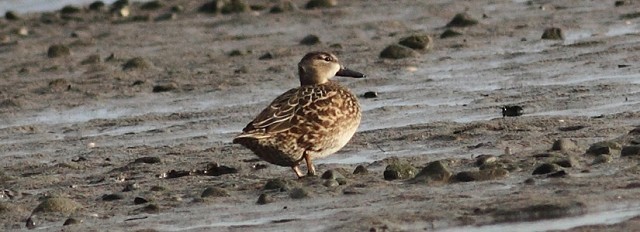
Blue-winged Teal, Bull Island, Dublin (Photo: Paul & Andrea Kelly)
Small numbers of Green-winged Teal continued to be reported, with drakes at Kinneil Lagoon (Forth) all week, Aberlady Bay (Lothian) to 21st and Caerlaverock (Dumfries & Galloway) to 19th. Other drakes were at Inner Marsh Farm (Cheshire) on 16th, Chew Valley Lake (Somerset) and Eyebrook Reservoir (Leicestershire) on 17th and Shannon Airport Lagoon (Co Clare) on 18th.
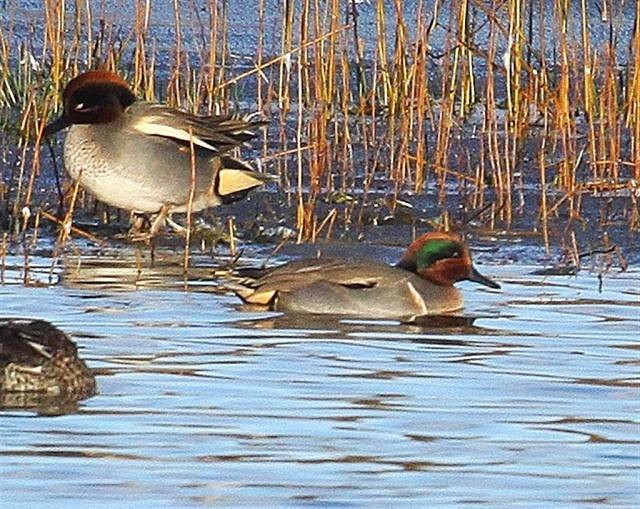
Green-winged Teal, Caerlaverock WWT, Dumfries & Galloway (Photo: Michael Foley)
The female Surf Scoter remained off Dawlish Warren (Devon) to 16th and there were also two males and a female from the ferry east of Fuday in the Sound of Barra (Outer Hebrides) on 22nd. The drake King Eider was still at Burghead (Moray & Nairn) on 17th, now starting to look very smart indeed. Other unusual wildfowl included up to eight Eiders at William Girling Reservoir (London) and the drake Garganey at Blunham (Bedfordshire) returned again on 19th for its fourth winter there — unusual behaviour, but there's no reason to doubt its provenance.

King Eider, Burghead, Moray & Nairn (Photo: Bob Johnson)
Smew were still widespread, at almost 45 sites across the country, including three sites in Nottinghamshire and Surrey. Peak counts continued to increase, though, with an astonishing 23 at Rutland Water and 22 at Pitsford Reservoir (Northamptonshire). There were also counts of 15 at both Dungeness (Kent) and Fen Drayton (Cambridgeshire).

Smew, Exminster Marshes RSPB, Devon (Photo: Charlie Fleming)

Smew, Minsmere RSPB, Suffolk (Photo: Jon Gibbs)
The gathering of Balearic Shearwaters in Carbis Bay (Cornwall) dropped to seven on 16th, increasing again to 18 by 21st. The only others were again off St Catherine's Breakwater (Jersey) on 17th, 20th and 22nd and off Prawle Point (Devon) on 19th. There was just one record of Sooty Shearwater, past St Ives (Cornwall) on 19th.
The only Glossy Ibis report this week was the reappearance of Berkshire's bird, again at Freeman's Marsh on 21st–22nd. With the cold weather biting, Bitterns have become much more visible, possibly with immigrants arriving from the Continent as well. Birds are widespread, and some sites have held numerous birds, including up to five at the London Wetland Centre and seven at Marazion (Cornwall).
Numbers of Great White Egrets continue to drop, with just four singletons reported this week: birds remained at West Hythe (Kent) and Hoveringham Gravel Pits (Nottinghamshire), with new birds over Wood Burcote (Northamptonshire) on 16th and at Great Shefford (Berkshire) on 21st–22nd. There was also a further report of four together at Cheddar Reservoir (Somerset) on 21st, presumably the birds that have been roosting recently at Shapwick Heath. The two Cattle Egrets remained at Grouville Marsh (Jersey) all week, with the bird again at Milton Clevedon (Somerset) on 16th.
Some of the now-wintering Spoonbills remained, including three on the Camel estuary (Cornwall) all week and three at Holes Bay (Dorset). Aside from two that commuted between St Mary's and Green Island (Isles of Scilly), all others were singletons, at Brownsea Island (Dorset), Arne (Dorset), Courtmachserry (Co Cork) and Cley Marshes (Norfolk).
The long-staying Rough-legged Buzzard was at South Ferriby (Lincolnshire) to at least 21st and one (or more) continued to wander the north Norfolk coast all week. Others were reported from Sandwich and Monks' Wall (Kent), Holme Fen and Great Shelford (Cambridgeshire), Stutton Mill (Suffolk) and Hutton-le-Hole (North Yorkshire) on 22nd. The juvenile male Northern Harrier also remained around Thornham (Norfolk) all week, allowing much better photographs to be taken. In Ireland, the juvenile also remained at Tacumshin (Co Wexford) to at least 19th.
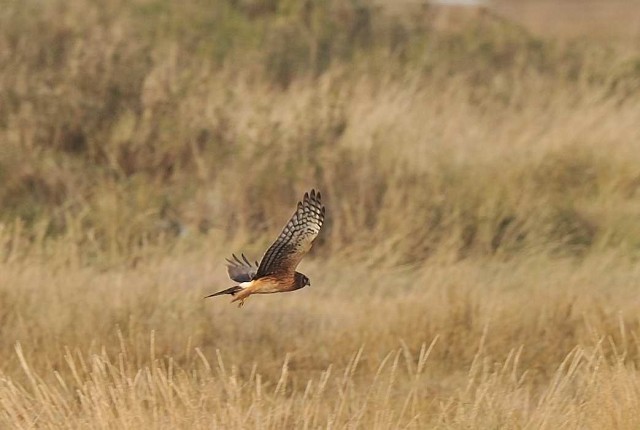
Northern Harrier, Thornham, Norfolk (Photo: Baz Scampion)
With no reports of Grey Phalarope, the only wader of interest was the Dorset Long-billed Dowitcher, which went wandering again, seen at Lodmoor on 16th and then at Butterstreet Cove on 17th, though not seen since.
An adult Bonaparte's Gull at Castle Eden Dene (Durham) on 20th was presumably the lingering bird from the autumn but, with it having been last seen on 24th October, and before that 11th September, it is interesting to speculate where it has been in-between times. Other 'larid' interest came in the form of a possible Laughing Gull at the shopping centre in Rathfarnham (Co Dublin) on 21st. The most interesting gull of the week though remains a mystery. A first-winter bird at Beddington (London) briefly on 22nd allowed some photos to be taken before disappearing off in the direction of the tip. There are various possibilities as to its identity, including such intriguing hybrids as 'Nelson's Gull' (American Herring Gull × Glaucous Gull) or 'Viking Gull' (Herring Gull × Glaucous Gull), or it may be a very pale American Herring Gull or one of those strange birds that emanate from Iceland. Hopefully it'll be refound, as it looks to be an instructive beast. More details are on Peter Alfrey's blog.
Glaucous Gulls were reported from up to 15 sites during the week, including three in Norfolk and two in Cambridgeshire. Iceland Gulls were less numerous, recorded at just 11 sites, with an adult, a third-winter and a juvenile at Stromness (Orkney) on 20th. Few of the more regular Ring-billed Gulls remained this week, with just the birds at Gosport (Hampshire) to 16th and Sands Lane Gravel Pit (West Yorkshire) to 17th. Other new birds included an adult at Par Beach (Cornwall) on 19th and one at Limerick (Co Limerick) again on 20th. In Staffordshire, a first-winter was at Blithfield Reservoir on 20th–21st and a second possible bird, an adult, was at Essington on 21st. Also in the Midlands, a second-winter was in Coventry (West Midlands) on 21st.

Glaucous Gull, Dogsthorpe Tip, Cambridgeshire (Photo: Josh Jones)
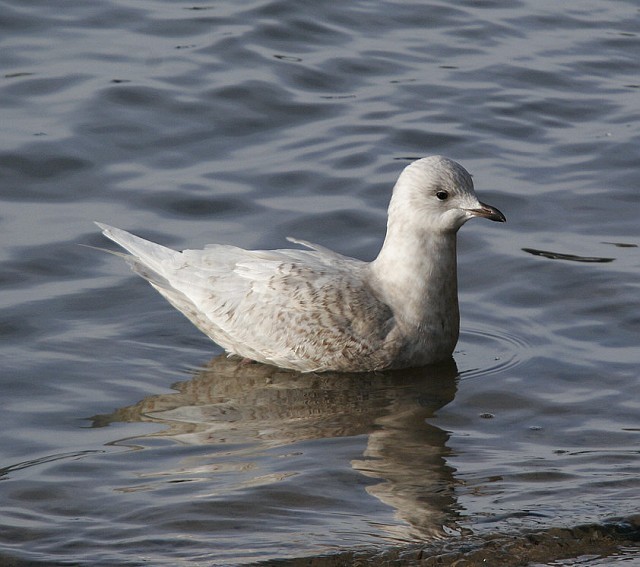
Iceland Gull, Lowestoft, Suffolk (Photo: Andrew Easton)

Ring-billed Gull, Limerick, Limerick (Photo: James Hayes)
There were few reports of Shore Larks during the week, with the peak counts being 21 at Gibraltar Point (Lincolnshire) and 15 at Holkham Gap (Norfolk). There were also three at Reculver and Coldharbour Lagoon (Kent) and singles at Dingle Marshes (Suffolk), Gorleston-on-Sea (Norfolk) and Stronsay (Orkney).
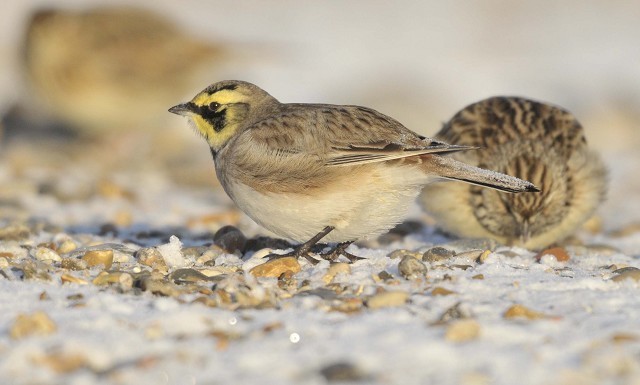
Shore Lark, Dingle Marshes SWT, Suffolk (Photo: Stephen Allen)
A quick look at the figures shows we put out 1,128 reports of Waxwings during the week, which is a great achievement by the News Team. It's not always been easy keeping up, but I think we have just about managed. There seems to be quite a good spread of birds now, with even the southwest seeing small numbers. Some very large groups do remain, though, and many seem to be in Kent poised to cross the Channel, with a peak of over 600 in Pegwell Bay.
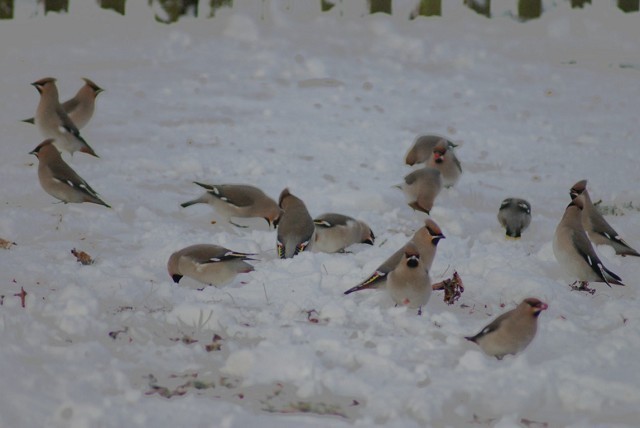
Waxwing, Ipswich, Suffolk (Photo: Bill Plumb)

Waxwing, Exmouth, Devon (Photo: anon)
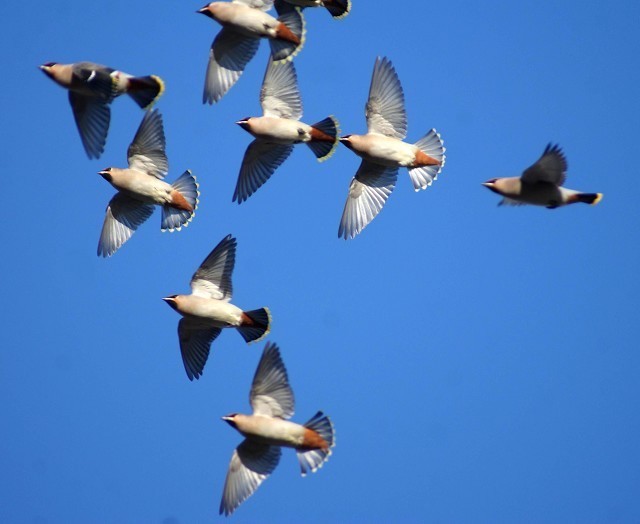
Waxwing, Ipswich, Suffolk (Photo: Bill Plumb)
With the Dorset Hoopoe long gone, only Jersey could hold on to one, at L'Etacq on 18th. There were only seven Great Grey Shrikes reported, with birds at Blashford Lakes and Aldershot (Hampshire), Arne (Dorset), Shapwick Heath (Somerset), Ashdown Forest (East Sussex), Flanders Moss (Forth) and the classic winter location of Budby Common (Nottinghamshire).
Perhaps not surprising considering the weather, there has been a dearth of passerine news. There have been plenty of records of Common Redpoll though, but the only redpoll of more interest was a Coues' Arctic Redpoll at Rainton Meadows (Durham) on 19th–21st. Most records of Lapland Buntings are now of single birds, with the only notable counts being 22 at Porth Joke (Cornwall), 12 at Breydon Water (Norfolk), 10 at Milford-on-Sea (Hampshire) and 10 at Abberton Reservoir (Essex). Another interesting reappearance this week was the Little Bunting in Suffolk. This was present at Great Glemham on 7th-8th December, but then popped up again in exactly the same place on 18th-19th. Presumably it had been present all along but gone unnoticed.

Lapland Bunting, Selsey West Fields, West Sussex (Photo: Dorian Mason)
The possible eastern Yellow Wagtail remained at Colyford Sewage Works (Devon) to 19th, so we will have to await the results of DNA analysis for any confirmation of its true identity. Other interesting races still around included a Central Asian Lesser Whitethroat at Neath (Glamorgan) on 21st and a female Northern Bullfinch at Blackborough End Tip (Norfolk) on 21st.
Photo of the Week: 16th–22nd December 2010

Waxwing, Folkestone, Kent (Photo: Steve Ashton)
For the past four years, Steve Ashton has been documenting the birdlife of Kent through his photos of both local species and visiting rarities. As well as his extensive image collection on BirdGuides and on his own website, Steve also brings to life the stories behind his birding exploits on his blog. In addition to thoroughly working his local area, Steve's success comes from working hard to get more than just a record shot of the birds he encounters, especially through capturing detail or behaviour in his images. This week, just when we were starting to think there were no new Waxwing images to be had, Steve proved us wrong with this superbly timed shot of two Waxwings 'sharing a berry'. Although it's not possible to tell exactly what's going on from the image, we're happy to go with the festive spirit and accept Steve's suggestion that it must be love! :)
Other notable photos

Whooper Swan, Martin Mere WWT, Lancashire (Photo: David Cookson)

White-tailed Eagle, Fishnish, Mull, Argyll (Photo: Betty McNair)

Black-headed Gull, undisclosed site, Lancashire (Photo: Tom Charles)

Crested Tit, Aviemore, Highland (Photo: Mark Hancox)

White-vented Storm-petrel, Ecuador (Photo: John Anderson)

Long-eared Owl, undisclosed site, Derbyshire (Photo: Richard Pittam)
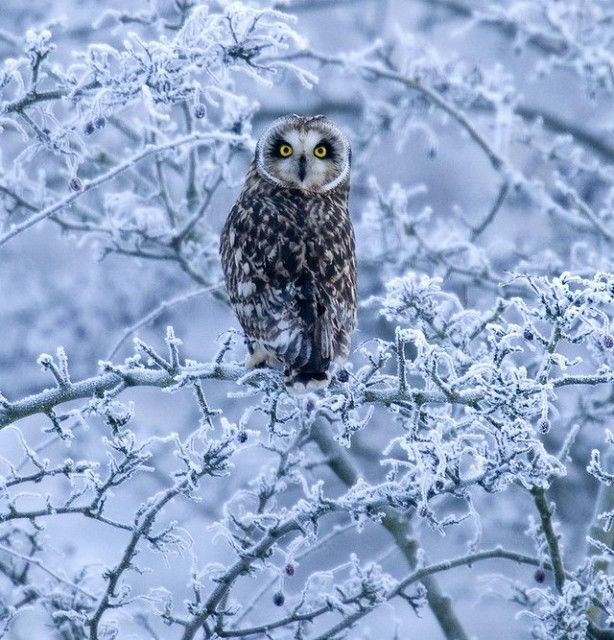
Short-eared Owl, Berry Hill Fields, Staffordshire (Photo: Nezzer)

Redwing, Meole Brace, Shropshire (Photo: John Fielding)

Starling, East Linton, Lothian (Photo: James Wood)

Sparrowhawk, Llandrindod Wells, Powys (Photo: Kev Joynes)

Goldfinch, Forest of Dean, Gloucestershire (Photo: Lewis Thomson)

Stock Dove, North Wirral, Cheshire (Photo: Richard Steel)

Nuthatch, Bolton Abbey, North Yorkshire (Photo: James Thomas)

Cattle Egret, Bahrain (Photo: Adrian Drummond-Hill)
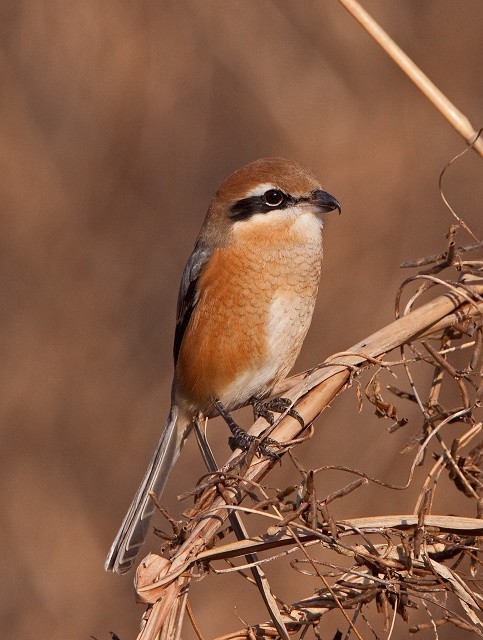
Bull-headed Shrike, Japan (Photo: Mark Curley)
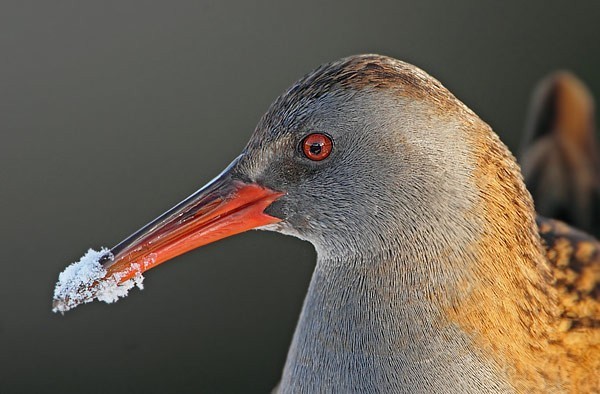
Water Rail, Chew Valley Lake, Somerset & Bristol (Photo: Gary Thoburn)

Smew, Stocker's Lake, Hertfordshire (Photo: Ian Curran)

Bittern, Stoke Newington Reservoirs, Greater London (Photo: Mark Pearson)

Merlin, Cleethorpes Coast LNR, Lincolnshire (Photo: Dave Bradbeer)

